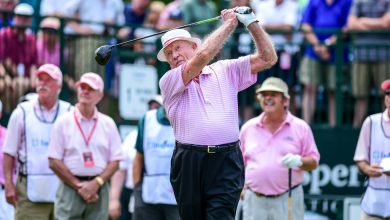For Dreadlocked N.F.L. Players, Hair Is a Point of Pride

It wasn’t until his junior year of college, in 2015, that Aaron Jones decided to rebel and form his hair into dreadlocks.
He said his parents, Alvin and Vurgess Jones, had warned him that Black people had long been targeted for discrimination, ostracism or punishment in school and the workplace for wearing their natural hair texture.
But as Jones matured, his parents’ stance softened, and Jones, the star running back for the Green Bay Packers, has now grown his dreadlocks for eight years so that they reach his collarbone, the tips of the barreling twists dyed a dark blond. During the N.F.L. season, he visits a stylist once every three months to re-twist them, he said, and he moisturizes his hair daily at home.
“I just think your hair is part of your strength, and I like the way it looks on me,” Jones said in a phone interview. “You just have to express yourself and do you.”
Dreadlocks are nothing new in football, where 58 percent of the league’s players are Black and approximately 18 percent of players on active N.F.L. rosters — or nearly one in five players on every club — wear their hair dreadlocked or braided, according to an informal tally compiled from roster headshots from all 32 teams.
But N.F.L. athletes’ personal style is constrained by uniform policies that are more strict than those in other pro leagues. Players spend most of their games with their faces covered by helmets, so they are aware that their hairstyles are an effective way to showcase their individuality on game days, at red carpet events and on their social media pages.
Lengths vary. Some players keep their twists short or tie them back. Others allow their hair to flow so that it seeps out of their helmets.

Tyreek Hill, a Miami Dolphins receiver who is considered one of the fastest players in the N.F.L., said he does not worry about being tackled by his hair. “I can’t really see myself being in a situation like that.”Credit…David Santiago/Miami Herald, via Associated Press
“You have guys with a lot of nationalities and personalities in the league and everyone wants to express themselves,” said Asante Samuel Jr., a second-year Chargers cornerback who has been growing his dreadlocks for about four years. “It’s just another way for guys to be themselves.”
Other dreadlocked players said their choice of style carries significance beyond just looks. San Francisco 49ers linebacker Fred Warner, whose dreadlocks reach near his collar, said he initially began growing them in 2018 for the aesthetic. But the hairstyle became more meaningful, he said, as he learned about its history and its influence on the Black community.
“It’s just Black culture, honestly,” said Warner, who identifies as Afro-Latino and American. “It’s just African American culture and what it means to us as Black people because it’s something mostly unique to us given our hair texture.
“I do take a lot of pride in it,” he added.
The former Arizona Cardinals receiver Larry Fitzgerald and the former Rams running back Steven Jackson were among the first big-name players to proudly wear hair so long that it partially covered the backs of their jerseys. They did so as the style’s popularity increased in the early aughts, confounding the league’s rule makers.
In 2003, after the former Miami Dolphins running back Ricky Williams was pulled down by his dreadlocks in a game, the N.F.L. ruled that hair was part of a player’s uniform and therefore legal to grab in pursuit of a tackle.
“I’ve been pulled by my hair a few times,” Jadeveon Clowney, then a linebacker with the Houston Texans, said after grabbing the locks of former Buffalo Bills running back Chris Ivory in a 2018 game. “But, hey, if they’re a part of the uniform and if I could reach for them again I would.”
Defensive players account for about 60 percent of players with dreadlocks or braids. They are rarely tackled unless they secure an interception or fumble.
“I’m not too worried about it, Warner said. “If they’re pulling my hair, that means I probably did something right and have the ball in my hands.”
Primary ball carriers who wear dreadlocks know the risks. Last season against the 49ers, Jones said, cornerback Josh Norman plucked partial strands of his hair out while attempting a tackle. Jones said the pulling did not hurt but as he jogged back to the huddle, he saw Norman with the twists in his raised hand.
“It was like he was celebrating,” Jones said, chuckling. “That was a first.”
Jones said he retrieved the hair from Norman and put it inside his sock for the rest of the drive. On the sideline, he gave it to equipment staff for safekeeping so he could later have it reattached.
Miami Dolphins receiver Tyreek Hill dreadlocked his hair after he was drafted in 2016. His locks do not yet extend past his helmet, but he doesn’t worry about the day they do.
“I rarely get tackled,” said Hill, one of the fastest players in the league. “I can’t really see myself being in a situation like that.”
Other players take measures to contain their locks. On game days, many wear a skull cap or headband under their helmets to tie them back, which also helps stop sweat and oil from dripping down their face.
In the past, Tennessee Titans running back Derrick Henry had his dreadlocks woven into a tightly knit fishtail braid that stretched just past his shoulder pads. Rams defensive back Jalen Ramsey, whose hair reaches his cheeks, has often worn a balaclava, a mask that wraps a person’s entire head, leaving only an opening for the eyes.
Keeping dreads neat inside the helmet can prevent opportunities for hair-pulling tackles and also make the player more comfortable. But it can also pose a challenge to fitting those helmets to provide their intended head protection.
The N.F.L. has invested over $200 million over the past decade in helmet and concussion research, including a $2 million grant competition to create a new “top performing helmet.” Jeff Miller, the N.F.L.’s executive vice president of communications, public affairs and policy, said in a statement that 67 percent of all players in the league this season are wearing helmets that snugly fit their head’s specific measurements.
Riddell, one of the leading helmet manufacturers, began producing models with “precision-fit” technology in 2017. To be fitted, players wear patterned hoods which are recognized as team equipment managers scan their heads using a cellphone app. Those images are sent to Riddell, which provides the players with a helmet with customized padding within four weeks of receiving their data.
“What player doesn’t want a helmet that fits them perfectly and has their name stitched into the lining?” said Thad Ide, the senior vice president of research and product development at Riddell.
But few “precision-fit” models allow for quick large-scale adjustments, Ide said, and if a player drastically changes his hairstyle during the season, he might need a new helmet. Brendan Burger, the Rams’ equipment director, said he always advises players to wear their hair exactly as they would in a game during the fitting process. Otherwise, the helmet may not be as comfortable or offer the best protection.
“That’s the key for me,” Burger said of dreadlocked players. “If you don’t, or you just let them hang down or whatever it may be, then it’s going to be a completely different fit.”
But that’s a small matter to players looking to be anything but uniform in their appearance. And those appearances may not be permanent. Warner said he expects to keep his dreadlocks for a long time. But the length may change. He slightly trimmed them this off-season, he said, at the request of Sydney Hightower, his wife.
“They were getting a little bit too long for her liking,” Warner said, laughing.




